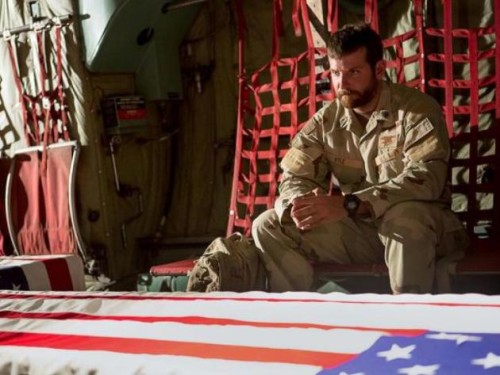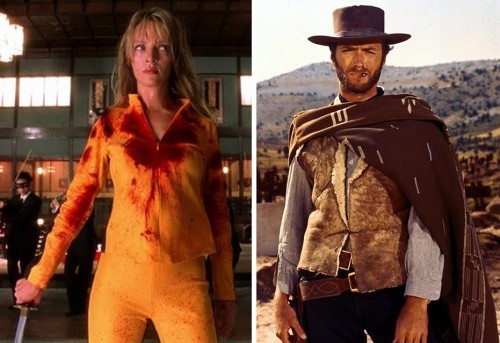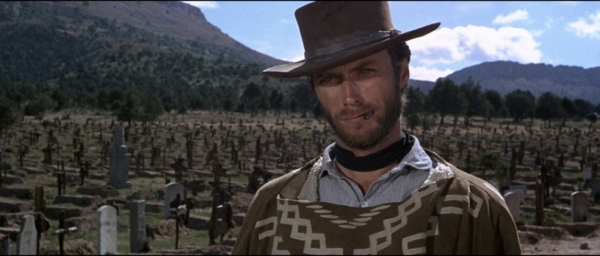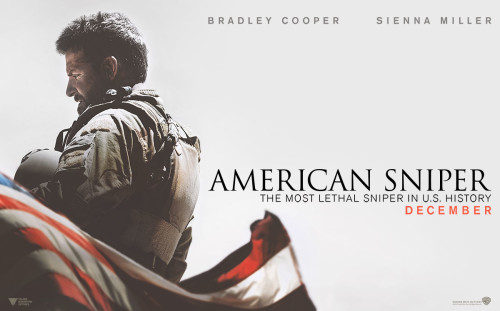
On Sept. 11, 2001, I was on the West Coast, living in the mountains of Southern Cali and preparing to go to work. A co-worker came running into our office screaming that the Twin Towers had fallen. Mind you, we were on West Coast time, and by the time I saw the attacks on television, the networks were on replay mode and editing footage deemed too gruesome for viewers.
Gathered around the one tiny TV in another office, my co-workers and I stared in disbelief, and the one thing I said out loud was something I remembered Malcolm X saying about chickens coming home to roost. “This is payback for something folks,” I said to them. While my co-workers were the flag-waving Patriotic types, I was already shaping this assault on American soil as retaliation for the untold dirt our military and government had done for years to countries who didn’t uphold our global agenda. This caused some ruffled feathers between me and some of my colleagues. It was a surreal moment. Our Pearl Harbor for the new millennia.
Looking back at the Sept. 11 attacks, it shouldn’t surprise me why American Sniper was such a big hit with the patriotic ‘muricah crowd. It is the military chicken soup of the soul cinema experience. It is propaganda of the highest order for viewers who need the Matrix blue pill to live with the lie of America’s War on Terror.
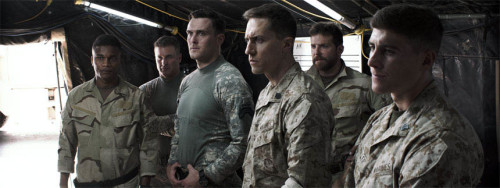
What makes American Sniper a disappointing viewing experience is not the ahistorical nature of the film, but quite frankly its generic storytelling. It’s downright boring. I may not agree with the politics of a film in order to enjoy it, but dammit, I have to be engaged with the content and its characters. The only time American Sniper really held my total interest was the appearance of a villainous character named Mustafa (played by Sammy Sheik), another sniper from Syria who we learn was a medal winning sharpshooter in the Olympics. He is for all intents and purposes Chris Kyle’s Arab counterpart. Sammy Sheik is riveting to watch in the brief moments we see him, although he never speaks. (Sidenote: every Arab character is a bad guy in this movie. There are no grays or complexity at all. Men, women, and children are all portrayed as evil, conniving, and dangerous. The idea that they could be defending their country from the cowboy antics of American soldiers is never even hinted at.)
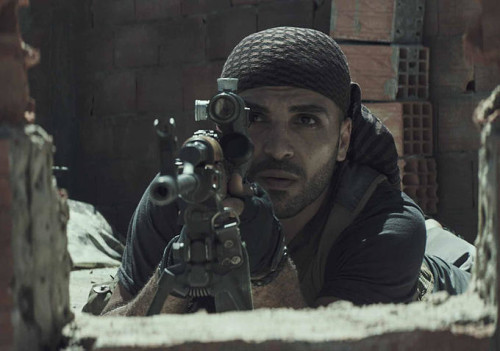
Bradley Cooper’s portrayal of Chris Kyle as a good ole boy going off to defend American citizens from the new Boogie-Men-of-the-Moment is pretty cut and dry. Usually Cooper is quite engaging to watch with his big baby blues and mega-watt smile. But here he’s not captivating at all, despite his eagerness to be serious and Oscar-worthy. His Kyle comes off as a big dumb reactionary bloke trying to find his manhood through “masculine” pursuits like bronco busting in rodeos and later a trumped up war (lest we forget, the excuse for bludgeoning Iraq was because U.S. intel claimed there was proof of W.M.D.’s—Weapons of Mass Destruction. There were no W.M.D.’s, and the 9/11 hijackers were from Saudi Arabia, but I digress). This cowboy motif is no accident, as it connects this film to the old John Ford Westerns and the nostalgia some folks feel about John Wayne flicks and the mythology of good white cowboys fighting off savage Indians who were keeping good white settlers from utilizing this “wilderness” that would become the U.S.A. Dehumanizing non-whites is the foundation for creating this nation. It’s the glue that holds apple pies and hot dogs together.

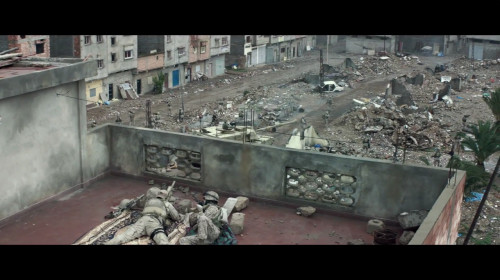
Clint Eastwood, a veteran of old school cowboy flicks and the poster boy for conservative old boy politics, paints American Sniper as another addition to that long line of wild west nostalgia in contemporary war cinema. Unfortunately the script tells us nothing new or insightful about the American psyche in relation to war today. As it stands, the simplistic plot of American Sniper tells us what we already know. Men are war, and American men thrive on it under the guise of Democracy and helping other countries liberate themselves from tyranny–by ironically (maybe intentionally) becoming the new tyranny in places we are supposed to be helping. Every generation, America creates new evil henchmen: Native Americans on the frontier, The Yellow Peril, Red Scare Russians, Black people and Civil Rights, Communist Cuba, and renegade North Korea. Since the 90s and our first trumped-up invasion of Iraq, the Arab world is the new thing that goes bump in the night. Our penchant for war only teaches us that xenophobia and colonialism never went away. We just dress them up with new language like insurgents and failing diplomacy.
Kyle’s indoctrination into war comes when he sees the bombing of the U.S. embassy in Kenya on television, and he only feels bad when he learns some Americans were killed. When the Twin Towers drop, he is gung ho to go to war. Not to protect people, but really, just to have something to do. Before the war, Kyle appears aimless, searching for a purpose. War gives him purpose. He gets married because that seems to be what he is supposed to do. He goes through life following a script pre-written for him. There are obligatory flashback scenes to show his stern father and the simplistic philosophy he was raised to believe in. That there is evil in the world at all times. That there are three types of people in the world: Wolves, sheep, and sheepdogs. And of course, a real man uses a gun and beats the crap out of people. Kyle internalizes these ideals, and carries them with him throughout the rest of his life.

The introduction of his wife, Taya (Sienna Miller), adds no meat to the story. She is regulated to being the good wife, the baby maker, the nagging spouse crying on the phone with an infant swinging off her breasts. (Let me say that the fake animatronic baby was creepy as hell and so distracting.) Although it probably wasn’t intended in the writing, you get the impression that Kyle preferred to be away from home not because he wanted to be a war hero, but because being a husband/father was a real drag for him.
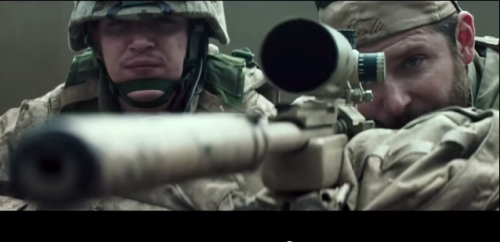
We are taken through Kyle’s four tour of duties, and each tour builds Kyle up as the sniper with the most kills. There are two scenes, one in the very beginning of the movie, and one later on, where Kyle is faced with the task of killing a child or not. These scenes are meant to show a moral dilemma, but they rang false to me because if someone is the deadliest sniper in American military history, they didn’t get that high body count by worrying about shooting children. There are no children in the Arab world according to this story. Just little insurgents ready to make war.
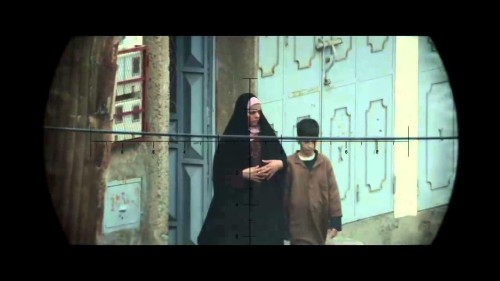
In the theater that I watched the film, a rotund older white gentleman (probably retired military by his crew cut) was actually rooting for Kyle to shoot a child. Because all the Arabs in the movie were considered “savages,” I have no doubt that Kyle never questioned or worried about assassinating children. They weren’t Americans, and therefore not human. (In real life, Chris Kyle bragged about shooting 30 Black people right after Hurricane Katrina in New Orleans. He bragged about killing fellow American citizens who I’m sure he didn’t view as human. His Katrina shootings were said to be a lie he made up, but his lies spoke volumes about his character. So his fictional quandary regarding Arab children rang false to me because we are never shown a man who questions anything ever. He’s just an unthinking workhorse used by the military.)
The concept of showing a man who just goes along with the war machine could be enhanced dramatically by having side characters who offer a different viewpoint. Unfortunately, we never spend too much time with side characters. The one character who does begin to question the meaning of this war, Marc ( Luke Grimes—who needs to be in more movies), barely registers a blip on Kyle’s radar of understanding. The plot drags on for over two hours until there’s a stand-off between Kyle and Mustafa. By then, when he’s about to get his ass handed to him by death, Kyle calls his wife and says he finally wants to come home. Not because war has changed his consciousness or philosophy, but because he’s losing a skirmish that he created by not following orders. He went rogue, it backfired, and now he wants out. That was the realest moment in the entire film. Not heroic, just honest human self-preservation.
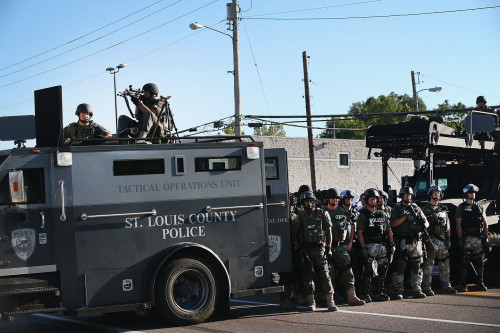

Watching an audience root for snipers to kill humans defending their right to exist on their own land reminded me of images of American snipers here in the states pointing guns at Black American citizens and their supporters protesting murders by cops in the United States. This same audience that cheered the heroics of Bradley Cooper as Chris Kyle probably cheered the actions of police forces on American streets aiming gun sights on folks with extra melanin. Cognitive dissonance is entrenched in the Patriotic American psyche. It allows Americans to rally around American Sniper, turning it into a blockbuster, while ignoring the home grown terrorism white Americans perpetuated against Black Americans that was depicted in the film Selma. I saw Americans of all colors streaming in to view Selma. American Sniper was vanilla heavy. Not a big surprise to me. Because, history.
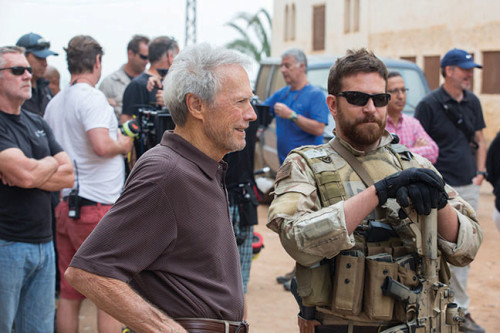
Clint Eastwood made spurious claims that American Sniper is an anti-war film. This disingenuous claim falls flat given the simplistic story-line, and the film’s ending dripping with flag waving from real-life footage of Kyle’s funeral. Had Eastwood really wanted to impress upon an audience the agonies of war, then he would be better off showing actual wounded veterans recovering from the various body traumas they come home with. A lot of flag-waving might become less vigorous when we see war up close and personal. Americans don’t know war. Not really. We watch it on TV like video games. We don’t sleep, eat, go to work, or go to school worrying about unmanned drones and bombs falling out of the sky from some hopped up dudebro with a military computer joystick thousands of miles away.
Unlike the rest of the world, Americans are spared from these continuous horrors and daily PTSD. We are coddled like babies, and this coddling has made us immature children in regards to war. So we deserve a movie like American Sniper. The only message it gives us (like it did Chris Kyle in real life), is that the war you perpetuate abroad will come back to haunt you in another form. Chickens coming home to roost indeed.
